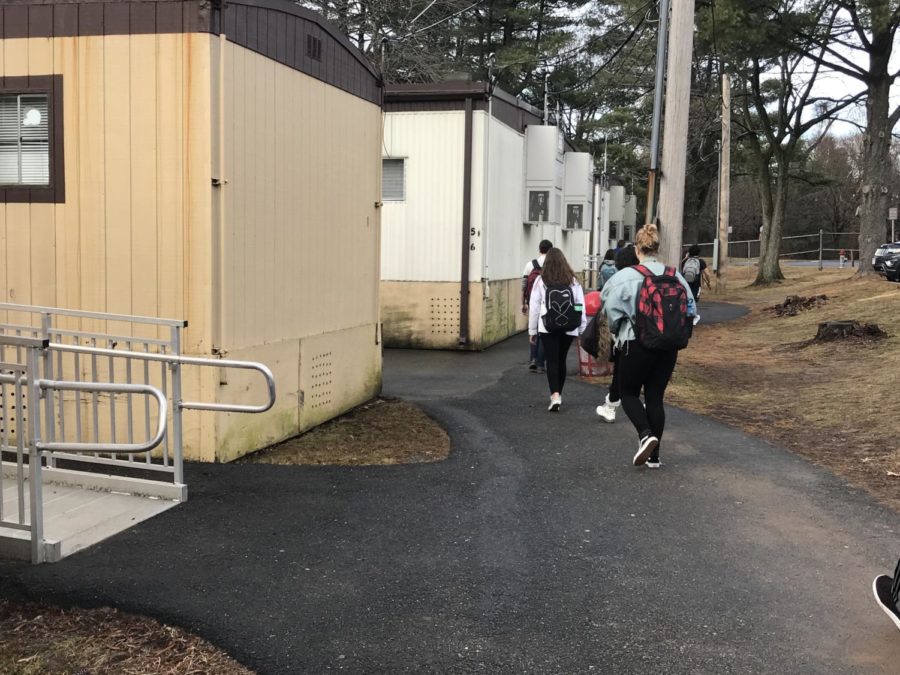Put trailer classes on trial
FCPS should renovate schools to eliminate trailer classes
June 11, 2018
The number of students in FCPS is growing rapidly, leading to crowded buses, traffic in the hallways and full classes. This overflow has resulted in an unreasonable increase in the number of trailer classes.
The number of FCPS students who have a trailer class is equivalent to the number of students in the entire Arlington or Richmond school districts.
School board member-at-large Ryan McElveen tweeted on Jan. 26 that the amount of trailer classes in FCPS “is a travesty…[it] is an embarrassment and it is unacceptable.”
Trailer classes are designed to be temporary, but they are being used as a permanent solution in FCPS schools.
“Trailers do serve an important purpose, which is to handle population fluxes and house classrooms during school renovations,” McElveen said at a Jan. 25 school board meeting.
The influx of trailer classes is an issue that is even more prevalent than it appears. Over the years, the amount of trailer classes has increased tremendously.
“Seventy-seven trailers housed 2,200 students, which was unacceptable to Fairfax citizens in 1950… Why would a number 10 times more than that be acceptable?” McElveen said.
Students who have trailer classes often experience polarizing weather conditions, from pouring rain to extreme humidity. Students who remain indoors do not have to endure such obstacles throughout the day.
“I have four trailer classes: English, math, history and Chinese. It can be quite bothersome constantly dealing with harsh weather conditions,” freshman Hyohyun Jung said.
Controlling the temperature in trailer classes can be a challenge when students constantly walk in and out of class, causing the temperature outside to diffuse with the temperature inside the trailers.
In addition, students are not able to attend their trailer classes when there are certain extreme weather conditions. The major wind storm on March 2 was a reminder of this concern in cases of emergency.
“If there is an issue with the trailers, we can always find some place in the school to get students in the building,” Director of Student Activities Greg Miller said.
While this is a good solution, hosting hundreds of students inside the school in non-classroom spaces would cause students to be distracted and could be a safety concern.
Math teacher Emily Fifer has been teaching at McLean for 10 years, four of which she has spent in a trailer class. When the enrollment at McLean increased, many teachers, including Fifer, volunteered to move out to a trailer. She has since found that having such classes can be beneficial.
“I’m in a quad trailer, so I can easily collaborate with other math teachers, and I don’t have to worry about other teachers coming into my classroom to teach on my off periods,” Fifer said.
But there are significant difficulties that come with teaching in the trailers. The bathrooms are far away, there are more insects and it is more difficult for teachers to socialize with colleagues in the building.
“I love being in a trailer class. However, I do miss the connections with other teachers or seeing students in the hallways during breaks,” Fifer said.
Currently, FCPS has more than 820 trailers housing around 20,000 students.
“If our kids who go to class each day in a trailer were a school district, they would be the 14th largest school system in the state,” McElveen said.
Full funding for FCPS facilities is necessary to reduce the number of trailer classes and allow for more room in schools.
“We would need $118 million in additional capital funding each year to allow us to meet a 25-year renovation cycle and eliminate most, if not all, trailer classrooms,” McElveen said. “I do not foresee our county leaders allocating that much bond funding to us in the near future.”
As difficult as it may be, county leaders must follow the steps suggested by McElveen to decrease the amount of trailers and provide a better learning environment for students.


